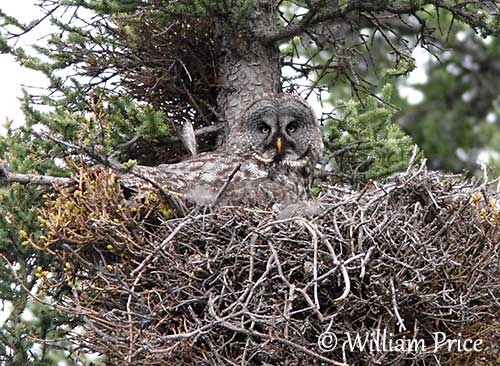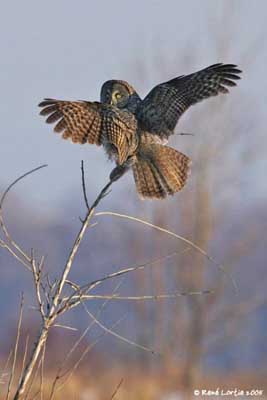
PROTECTION / THREATS / STATUS:
The Great Grey Owl’s populations are not threatened at this moment.
In North America, they can be threatened by timber-harvesting, reducing the leaning trees for the young and the large-diameter trees for nesting. Collisions with vehicles can be important in some years. Human disturbances also play an important role.
However, this species is generally scarce, but not currently endangered.
Fr: Chouette lapone
All : Bartkauz
Esp: Cárabo Lapón
Ital: Allocco di Lapponia
Nd: Laplanduil
Sd: Lappuggla
Photographers:
René Lortie
http://rlortie.ca
William Price
PBase-tereksandpiper & Flickr William Price
Text by Nicole Bouglouan
Sources:
HANDBOOK OF THE BIRDS OF THE WORLD Vol 5 by Josep del Hoyo-Andrew Elliott-Jordi Sargatal - Lynx Edicions - ISBN: 8487334253
THE HANDBOOK OF BIRD IDENTIFICATION FOR EUROPE AND THE WESTERN PALEARCTIC by Mark Beaman, Steve Madge - C.Helm - ISBN: 0713639601
L’ENCYCLOPEDIE MONDIALE DES OISEAUX - Dr Christopher M. Perrins - BORDAS - ISBN: 2040185607
ENCYCLOPEDIE DES OISEAUX DE FRANCE ET D’EUROPE – de Peter Hayman et Rob Hume - Flammarion – ISBN : 2082009920
Owling.com – The largest US website totally dedicated to owls
Wikipedia (Wikipedia, The Free Encyclopedia)
Great Grey Owl
Strix nebulosa
Strigiforme Order – Strigidae Family
BIOMETRICS:
Length: 60-70 cm
Wingspan: 142-152 cm
Weight: M: 800-1175 g – F: 925-1700 g
DESCRIPTION:
The Great Grey Owl is a large Strigidae species of the northern hemisphere.
With very secretive habits, this owl is rarely seen and often named Great grey Ghost or Phantom of the North.

The adult has dark grey to grey-brown upperparts with greyish-white and dark vermiculations and dark streaks. Upperwing and tail are conspicuously barred dark and pale grey.
The underparts are pale greyish with faint vermiculations, and broad, dark grey streaks.
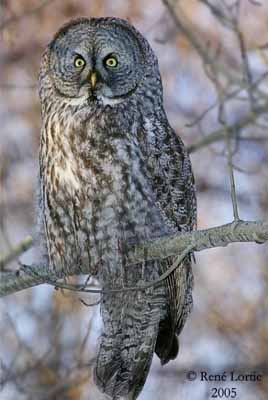
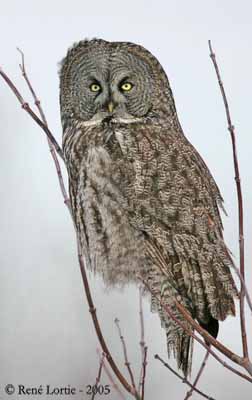
On the large, rounded head, we can see a large circular facial disk consisting in six or more dark grey or brown concentric rings. Eyebrows and lores are whitish. The chin is black with broad white sides.
The thin, hooked bill is yellowish to horn-coloured. The eyes are yellow. Legs and feet are thickly feathered grey.
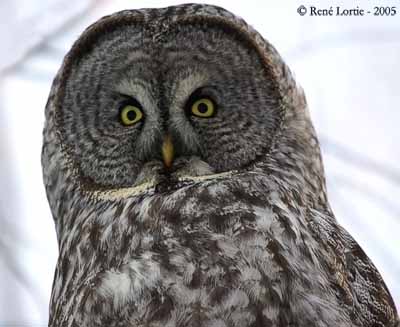
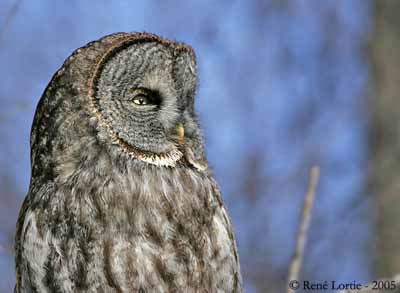
Both sexes are similar in plumage, but the female is larger than the male.
The juvenile shows cryptic grey and white plumage.
We can find two subspecies:
S.n. nebulosa is found in North America, from C Alaska, E to SW Quebec, S to EC California, N Idaho and NE Minnesota.
S.n. lapponica from northern Eurasia to NE China. This one can be paler than nominate, with whiter underparts and more clearly streaked.
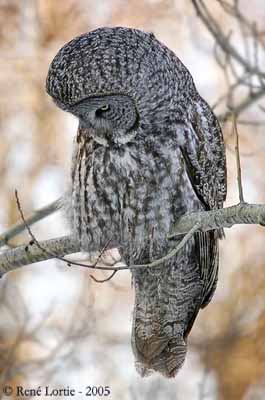
VOICE: SOUNDS BY XENO-CANTO
The Great Grey Owl male gives advertising calls, a series of 8-12 weak, deep, spaced hoots “buoo buoo buoo…” accelerating first and falling in pitch and intensity towards the end. The female utters higher-pitched sounds.
We can also hear a muffled “woo-oo woo-oo” by the male, and a weaker “woo woo” by the female.
The alarm call is a deep, growling “grrrrrrok”.
HABITAT:
The Great Grey Owl frequents dense boreal or coniferous forests with open areas such as taiga with bogs or open fields. It also frequents pine and fir forests close to high meadows, and black spruce forests.
Outside the breeding period, this species may occur near habitations.
It can be seen from sea-level up to 1000 metres of elevation, but higher according to the range, up to 2400 metres in California and 3200 metres in Utah.
RANGE:
The Great Grey Owl is a species of the Northern hemisphere.
See the range above in “subspecies”.
BEHAVIOUR:
The Great Grey Owl feeds mainly on rodents, but it can take birds, amphibians and large insects.
The most part of its diet during the breeding season includes voles, and it takes mice, squirrels, shrews and rabbits in winter.
This species can be diurnal, but it hunts mainly at dusk and by night. It hunts from a perch by listening and watching the ground. Once the prey is detected, it swoops down and snatches up the victim.
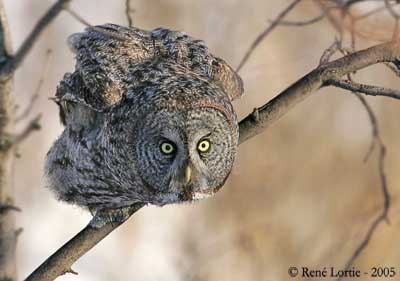
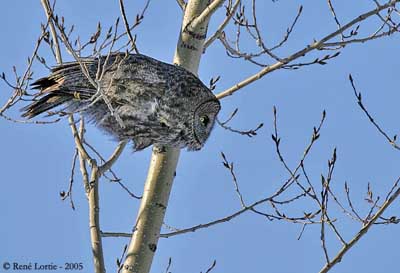
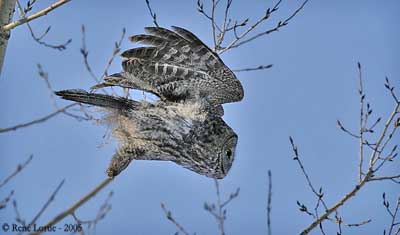
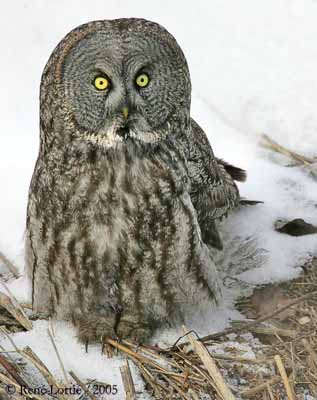
The preys can be detected and caught beneath the snow, only through the sound, thanks to the keen sense of hearing. The Great Grey Owl can hover first, and then, it plunges head first with face downwards, breaks through the snow cover and grabs the prey with the talons, even in cover as deep as 45 centimetres.
It can swallow the small rodents whole, but the larger preys are pulled into pieces. It rejects large greyish-black, compact pellets.
The Great Grey Owl is territorial and very aggressive in nest defence. It strongly attacks the intruders, and can strike human, involving serious injuries.
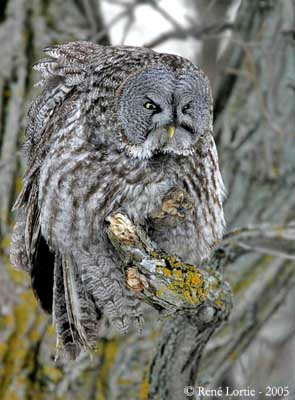
At the beginning of the breeding season, some displays such as feeding and mutual preening occur between mates. The male presents the food with the bill to the female, and the birds close the eyes while the food is passed.
It also attracts the female by calling at potential nest-sites, and can perform aerial displays.
The Great Grey Owl is resident in its range, and only performs some movements according to the prey availability. These movements can gather concentration of birds, probably related to the food abundance.
FLIGHT:
The Great Grey Owl performs steady, determined flight with deep and slow wing-beats.
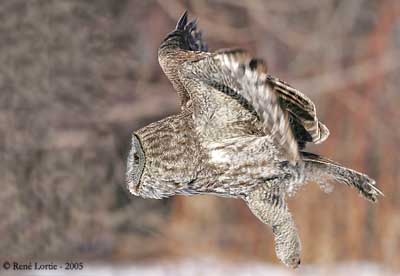
REPRODUCTION:
The breeding season occurs between March and July in North America and between March and August in Europe.
The Great Grey Owl is usually monogamous and the pair forms in January. They often use abandoned nests by birds of prey, or establish a nest-site on broken tree snag or artificial platforms, and occasionally in a depression on the ground, at tree base. They do not add material.
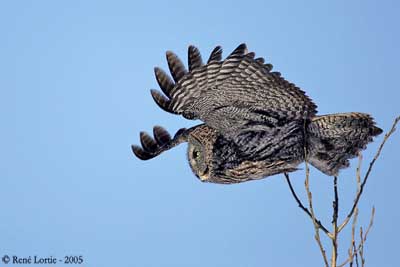
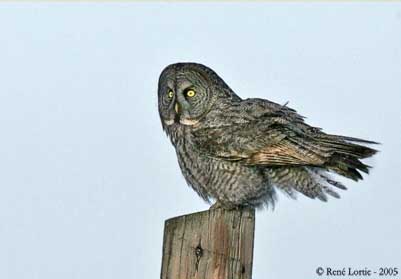
The female lays 3-5 eggs, depending on the food resources. A second brood can be laid if the first eggs are destroyed. She incubates during about 28-36 days while the male feeds her on the nest.
At hatching, the chicks are covered in whitish-grey down. The young leave the nest about 25-30 days after hatching, but they are unable to fly. However, they climb leaning trees to roost. They can fly one or two weeks later. The male feeds them after they fledge.
They can breed between one and three years.
DIET:
The Great Grey Owl feeds mainly on small mammals such as rodents, rats, mice, shrews, squirrels, chipmunks, moles, weasels and rabbits. It can catch some birds such as corvids and small birds of prey, thrushes, ducks and grouses. It also takes sometimes amphibians, snakes and large insects.
It hunts by day and by night, and is often see on exposed perches on the road side where it uses the typical “sit-and-wait”, but in forested areas, it flies low from the ground. It plunges into the snow to catch a prey detected by hearing.
